【Unity学习笔记】掌握MoneBehavior中的重要属性、方法
一、重要属性
1-1.获取自己依附的GameObject
using System.Collections;
using System.Collections.Generic;
using UnityEngine;
public class Lesson3 : MonoBehaviour
{
private void Start()
{
//Mono里已经封装好了属性gameObject
//可以通过gameObject属性来获取
//(this.是可以省略的,为了便于理解 在前面加上this)
//打印出它的名字
print(this.gameObject.name);
}
}

1-2.获取自己依附的GameObject的位置信息
using System.Collections;
using System.Collections.Generic;
using UnityEngine;
public class Lesson3 : MonoBehaviour
{
private void Start()
{
//使用transform.出来
//(this.是可以省略的,为了便于理解 在前面加上this)
//获取坐标
print(this.transform.position);
//获取角度(欧拉角)
print(this.transform.eulerAngles);
//获取缩放
print(this.transform.lossyScale);
//这种写法和上面是一样的
print(this.gameObject.transform);
}
}

1-3.设置脚本的 激活 与 失活
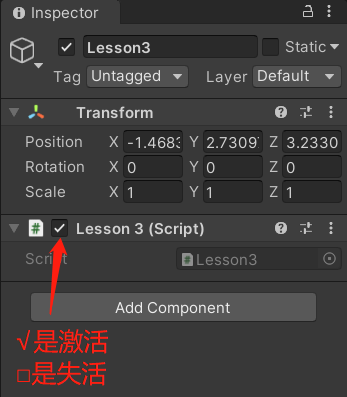
using System.Collections;
using System.Collections.Generic;
using UnityEngine;
public class Lesson3 : MonoBehaviour
{
private void Start()
{
//(this.是可以省略的,为了便于理解 在前面加上this)
//激活
this.enabled = true;
//失活
this.enabled = false;
}
}
1-4.获取别的游戏对象的gameObject和transform
using System.Collections;
using System.Collections.Generic;
using UnityEngine;
public class Lesson3 : MonoBehaviour
{
//因为两个物体挂的都是Lesson3脚本
//所以声明一个Lesson3类型的变量
public Lesson3 otherLesson3;
private void Start()
{
//获取别的脚本对象依附的gameobject和transform信息
//(this.是可以省略的,为了便于理解 在前面加上this)
print(otherLesson3.gameObject.name);
print(otherLesson3.transform.position);
}
}
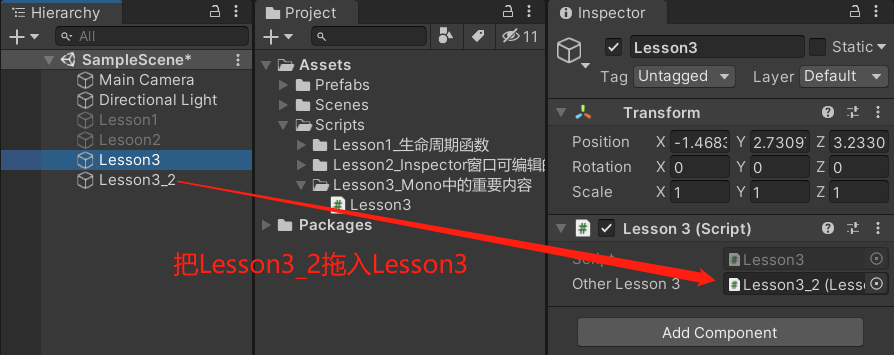
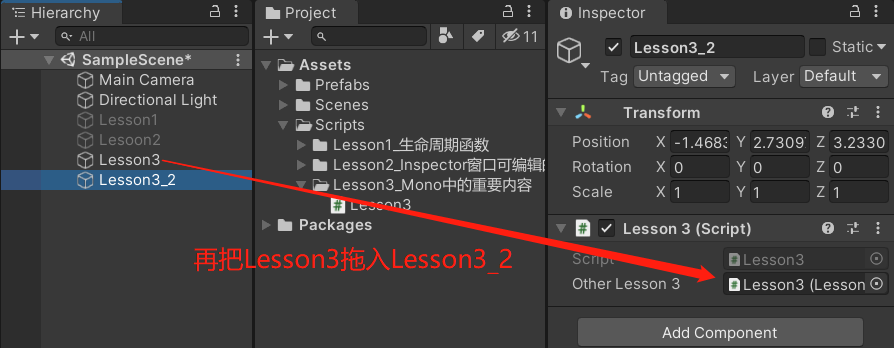
打印结果:

二、重要方法
主要内容:得到依附游戏对象上挂载的其它脚本
只要得到了场景中游戏物体 或 它身上依附的脚本,那么 就可以得到它的一切信息
2-1.得到和自己依附在同一游戏物体上的另一个脚本(很少用)
现有一个Lesson3物体,上面挂载了两个脚本
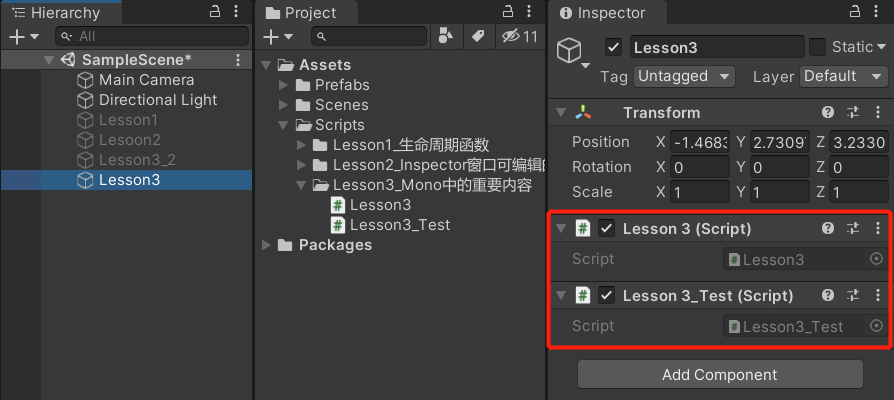
脚本Lesson3代码:
using System.Collections;
using System.Collections.Generic;
using UnityEngine;
public class Lesson3 : MonoBehaviour
{
private void Start()
{
//因为我们知道要获取的脚本是Lesson3_Test,所以直接使用Lesson3_Test类型的变量去接收它的返回值
Lesson3_Test t = null;
//得到和自己依附在同一游戏物体上的另一个脚本
//1.根据脚本名获取(很少用)
// 需要用里氏替换原则把返回值 as 成Lesson3_Test
// 如果没找到""里的那个脚本,就默认返回null
t = this.GetComponent("Lesson3_Test") as Lesson3_Test;
print(t);
//2.根据Type获取(反射的知识)
// 需要用里氏替换原则把返回值 as 成Lesson3_Test
t = this.GetComponent(typeof(Lesson3_Test)) as Lesson3_Test;
print(t);
//3.通过泛型获取(用的最多,因为不用as了)
// 默认就返回Lesson3_Test类型,不需要as转换了
t = this.GetComponent<Lesson3_Test>();
print(t);
}
}
运行:

2-2.得到自己挂载的多个脚本
现有一个Lesson3物体,上面挂载了两个脚本
Lesson3脚本的代码:
using System.Collections;
using System.Collections.Generic;
using UnityEngine;
public class Lesson3 : MonoBehaviour
{
private void Start()
{
//1.用数组得到Lesson3上挂载的所有脚本
//需要用一个Lesson3类型的数组去接收返回值
Lesson3[] array = this.GetComponents<Lesson3>();
print(array.Length);
//2.用List得到Lesson3上挂载的所有脚本
//声明一个Lesson3类型的List
List<Lesson3> list = new List<Lesson3>();
//用这个List去存获取的结果
this.GetComponents<Lesson3>(list);
print(list.Count);
}
}
运行:

------------恢复内容开始------------
# 一、重要属性
1-1.获取自己依附的GameObject
using System.Collections;
using System.Collections.Generic;
using UnityEngine;
public class Lesson3 : MonoBehaviour
{
private void Start()
{
//Mono里已经封装好了属性gameObject
//可以通过gameObject属性来获取
//(this.是可以省略的,为了便于理解 在前面加上this)
//打印出它的名字
print(this.gameObject.name);
}
}

1-2.获取自己依附的GameObject的位置信息
using System.Collections;
using System.Collections.Generic;
using UnityEngine;
public class Lesson3 : MonoBehaviour
{
private void Start()
{
//使用transform.出来
//(this.是可以省略的,为了便于理解 在前面加上this)
//获取坐标
print(this.transform.position);
//获取角度(欧拉角)
print(this.transform.eulerAngles);
//获取缩放
print(this.transform.lossyScale);
//这种写法和上面是一样的
print(this.gameObject.transform);
}
}

1-3.设置脚本的 激活 与 失活

using System.Collections;
using System.Collections.Generic;
using UnityEngine;
public class Lesson3 : MonoBehaviour
{
private void Start()
{
//(this.是可以省略的,为了便于理解 在前面加上this)
//激活
this.enabled = true;
//失活
this.enabled = false;
}
}
1-4.获取别的游戏对象的gameObject和transform
using System.Collections;
using System.Collections.Generic;
using UnityEngine;
public class Lesson3 : MonoBehaviour
{
//因为两个物体挂的都是Lesson3脚本
//所以声明一个Lesson3类型的变量
public Lesson3 otherLesson3;
private void Start()
{
//获取别的脚本对象依附的gameobject和transform信息
//(this.是可以省略的,为了便于理解 在前面加上this)
print(otherLesson3.gameObject.name);
print(otherLesson3.transform.position);
}
}


打印结果:

二、重要方法
主要内容:得到依附游戏对象上挂载的其它脚本
只要得到了场景中游戏物体 或 它身上依附的脚本,那么 就可以得到它的一切信息
2-1.得到和自己依附在同一游戏物体上的另一个脚本(很少用)
现有一个Lesson3物体,上面挂载了两个脚本

脚本Lesson3代码:
using System.Collections;
using System.Collections.Generic;
using UnityEngine;
public class Lesson3 : MonoBehaviour
{
private void Start()
{
//因为我们知道要获取的脚本是Lesson3_Test,所以直接使用Lesson3_Test类型的变量去接收它的返回值
Lesson3_Test t = null;
//得到和自己依附在同一游戏物体上的另一个脚本
//1.根据脚本名获取(很少用)
// 需要用里氏替换原则把返回值 as 成Lesson3_Test
// 如果没找到""里的那个脚本,就默认返回null
t = this.GetComponent("Lesson3_Test") as Lesson3_Test;
print(t);
//2.根据Type获取(反射的知识)
// 需要用里氏替换原则把返回值 as 成Lesson3_Test
t = this.GetComponent(typeof(Lesson3_Test)) as Lesson3_Test;
print(t);
//3.通过泛型获取(用的最多,因为不用as了)
// 默认就返回Lesson3_Test类型,不需要as转换了
t = this.GetComponent<Lesson3_Test>();
print(t);
}
}
运行:

2-2.得到自己挂载的多个脚本
现有一个Lesson3物体,上面挂载了两个脚本
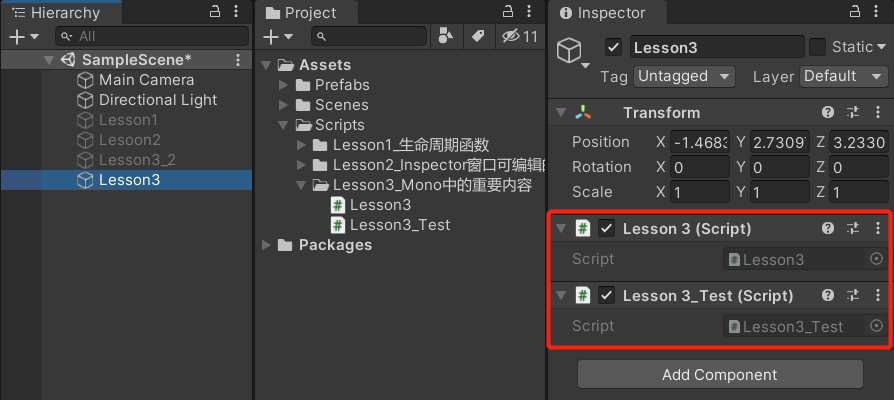
Lesson3脚本的代码:
using System.Collections;
using System.Collections.Generic;
using UnityEngine;
public class Lesson3 : MonoBehaviour
{
private void Start()
{
//1.用数组得到Lesson3上挂载的所有脚本
//需要用一个Lesson3类型的数组去接收返回值
Lesson3[] array = this.GetComponents<Lesson3>();
print(array.Length);
//2.用List得到Lesson3上挂载的所有脚本
//声明一个Lesson3类型的List
List<Lesson3> list = new List<Lesson3>();
//用这个List去存获取的结果
this.GetComponents<Lesson3>(list);
print(list.Count);
}
}
运行:

2-3.得到子对象挂载的脚本
(它默认也会找自己身上是否挂载了该脚本)
(儿子的儿子也会去找)
现有:
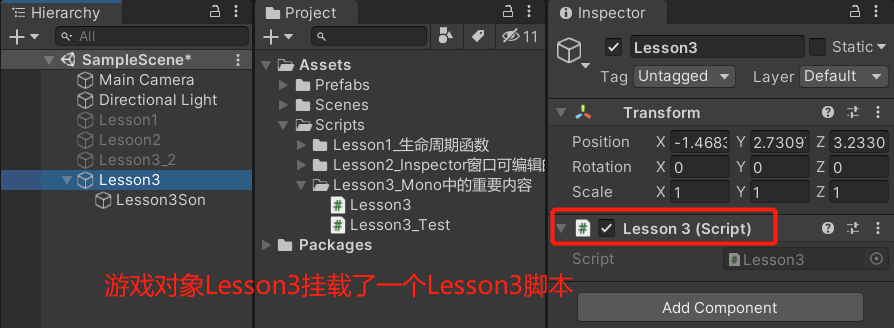
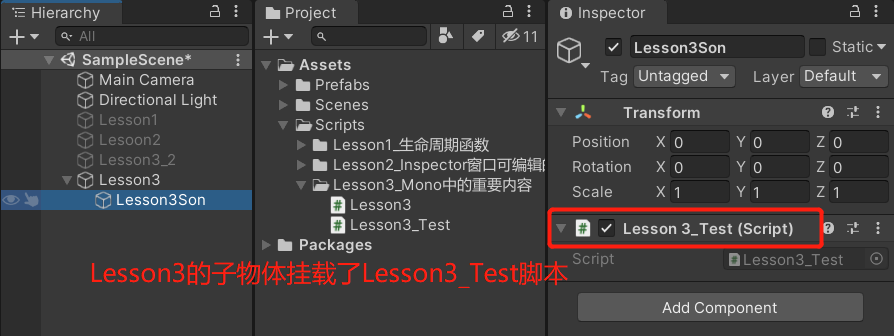
Lesson3脚本代码:
using System.Collections;
using System.Collections.Generic;
using UnityEngine;
public class Lesson3 : MonoBehaviour
{
private void Start()
{
//因为我们知道要获取的脚本是Lesson3_Test,所以直接使用Lesson3_Test类型的变量去接收它的返回值
Lesson3_Test t = null;
//得到单个
//使用GetComponentInChildren<>来获取子对象挂载的某个脚本
//()中的参数:是否检测失活的,不填默认false
t = this.GetComponentInChildren<Lesson3_Test>(true);
print(t);
//得到多个
//使用GetComponentsInChildren<>来获取子对象挂载的多个脚本
//方法一:用数组
//用一个Lesson3_Test类型的数组去接收返回值
Lesson3_Test[] array = this.GetComponentsInChildren<Lesson3_Test>(true);
print(array.Length);
//方法二:用List得到Lesson3的子对象上挂载的所有脚本
//声明一个Lesson3类型的List
List<Lesson3_Test> list = new List<Lesson3_Test>();
//把获取到的子对象的脚本装入list
this.GetComponentsInChildren<Lesson3_Test>(true,list);
print(list.Count);
}
}
运行:

2-4.得到父对象挂载的脚本
(它默认也会找自己身上是否挂载了该脚本)
(父亲的父亲也会去找)
现有:
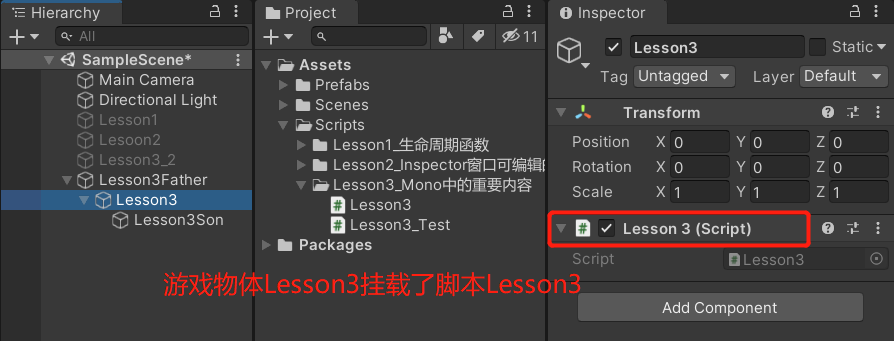
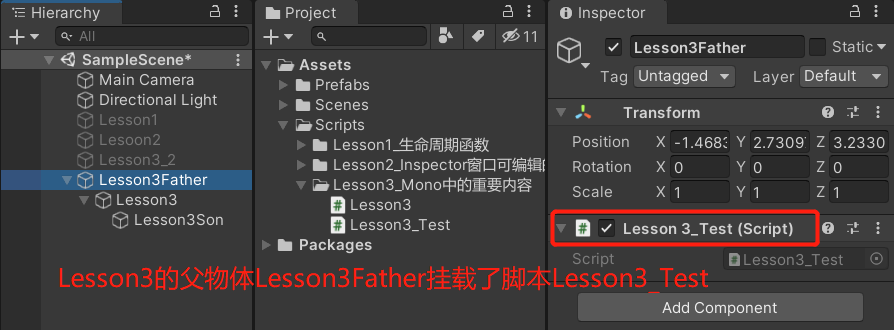
Lesson3脚本的代码:
using System.Collections;
using System.Collections.Generic;
using UnityEngine;
public class Lesson3 : MonoBehaviour
{
private void Start()
{
//因为我们知道要获取的脚本是Lesson3_Test,所以直接使用Lesson3_Test类型的变量去接收它的返回值
Lesson3_Test t = null;
//得到单个
//使用GetComponentInParent<>来获取父对象挂载的某个脚本
t = this.GetComponentInParent<Lesson3_Test>();
print(t);
//得到多个
//使用GGetComponentsInParent<>来获取父对象挂载的多个脚本
//方法一:用数组
//用一个Lesson3_Test类型的数组去接收返回值
Lesson3_Test[] array = this.GetComponentsInParent<Lesson3_Test>();
print(array.Length);
//方法二:用List存Lesson3的父对象上挂载的所有脚本
//声明一个Lesson3类型的List
List<Lesson3_Test> list = new List<Lesson3_Test>();
//把获取到的父对象的脚本装入list
this.GetComponentsInParent<Lesson3_Test>(true,list);
print(list.Count);
}
}
运行:

2-5.尝试获取脚本
之前在得单个脚本的时候,有可能没得到 为null
为了保险起见,往往得到脚本后会先判断它不为空 再进行逻辑处理
所以提供了一个更加安全的方法this.TryGetComponent<>
using System.Collections;
using System.Collections.Generic;
using UnityEngine;
public class Lesson3 : MonoBehaviour
{
private void Start()
{
//因为我们知道要获取的脚本是Lesson3_Test,所以直接使用Lesson3_Test类型的变量去接收它的返回值
Lesson3_Test t = null;
//this.TryGetComponent<>会有一个bool型的返回值
//通过out把得到的脚本装进t
if (this.TryGetComponent<Lesson3_Test>(out t))
{
print("成功获取了");
}
}
}
【Unity学习笔记】掌握MoneBehavior中的重要属性、方法的更多相关文章
- python学习笔记013——模块中的私有属性
1 私有属性的使用方式 在python中,没有类似private之类的关键字来声明私有方法或属性.若要声明其私有属性,语法规则为: 属性前加双下划线,属性后不加(双)下划线,如将属性name私有化,则 ...
- C语言学习笔记--C语言中变量的属性关键字
变量属性关键字的使用语法:property type var_name; 1.auto 关键字 auto关键字是C语言中局部变量的默认的关键字,C编译器默认所有的局部变量都是auto的,它表明了被修饰 ...
- [学习笔记]node.js中的path.extname方法
path.extname 返回path路径文件扩展名,如果path以 ‘.' 为结尾,将返回 ‘.',如果无扩展名 又 不以'.'结尾,将返回空值. path.extname('index.html' ...
- VBA学习笔记(1)----VBA对象属性方法
'VBA对象 'VBA中的对象其实就是我们操作的具有方法.属性的excel中支持的对象 'Excel中的几个常用对象表示方法 '1.工作簿 ' Workbooks 代表工作簿集合,所有的工作簿,Wor ...
- 并发编程学习笔记(4)----jdk5中提供的原子类及Lock使用及原理
(1)jdk中原子类的使用: jdk5中提供了很多原子类,它会使变量的操作变成原子性的. 原子性:原子性指的是一个操作是不可中断的,即使是在多个线程一起操作的情况下,一个操作一旦开始,就不会被其他线程 ...
- [学习笔记] 在Eclipse中导入项目
参考前文:[学习笔记] 在Eclips 中导出项目 选择已经导出的文件: 导入之后,项目结构如下: 至此,完成.
- CockroachDB学习笔记——[译]CockroachDB中的SQL:映射表中数据到键值存储
CockroachDB学习笔记--[译]CockroachDB中的SQL:映射表中数据到键值存储 原文标题:SQL in CockroachDB: Mapping Table Data to Key- ...
- [学习笔记] 在Eclipse中导出可以直接运行的jar,依赖的jar中的类解压后放在运行jar中
前文: [学习笔记] 在Eclipse中导出可以直接运行的jar,依赖的jar打在jar包中 使用7z打开压缩包,查看所有依赖的jar都被解压以包名及class的方式存储在了运行jar中,此时jar的 ...
- [学习笔记] 在Eclipse中导出可以直接运行的jar,依赖的jar打在jar包中
本文需要参考前文: [学习笔记] 在Eclipse中导出可以直接运行的jar,依赖的jar在子目录中 上文是导出的运行的依赖jar被放在了子目录中,本文是将依赖jar放在可运行jar的本身,这样发布的 ...
- [学习笔记] 在Eclipse中导出可以直接运行的jar,依赖的jar在子目录中
工程创建可参考前文: [学习笔记] 在Eclipse中使用Hibernate,并创建第一个工程,数据库为Oracle XE 在工程上鼠标右键: 找到java 选择 Runable JAR file N ...
随机推荐
- ONNXRuntime学习笔记(三)
接上一篇完成的pytorch模型训练结果,模型结构为ResNet18+fc,参数量约为11M,最终测试集Acc达到94.83%.接下来有分两个部分:导出onnx和使用onnxruntime推理. 一. ...
- 2.4 小白必看:零基础安装Linux系统(超级详细)
我们以新发布的 CentOS 8.1 为例,学习如何安装Linux系统. 准备工作: 1. 一台可以访问互联网的电脑 2. VMware Workstation安装包 3. CentOS8.1镜像文件 ...
- 巧用 Docker 快速部署 GPU 环境
公众号关注 「开源Linux」 回复「学习」,有我为您特别筛选的学习资料~ 在 Linux 服务器上使用 GPU 跑深度学习的模型很正常不过.如果我们想用 Docker 实现同样的需求,就需要做些额外 ...
- 详解:什么是VXLAN?
点击上方"开源Linux",选择"设为星标"回复"学习"获取独家整理的学习资料! 本文介绍了什么是VXLAN,以及VXLAN的基本概念和工作 ...
- springCloud 微服务通过minio实现文件上传和文件下载接口
直接上代码吧,好多文章的下载都写的不明不白的,让人理解错,气死了!! 文件上传功能 文件上传很简单,首先你得部署好minio,然后写好配置信息,我的是动态读取nacos上配置的yml @Autowir ...
- Element中使用el-select选中后不显示值
<el-select v-model="form.data" placeholder="选择参数" @change="changeThis&qu ...
- MySQL分库分表-理论
分库分表的几种方式 把一个实例中的多个数据库拆分到不同的实例 把一个库中的表分离到不同的数据库中 数据库分片前的准备 在数据库并发和负载没有达到限制时,不推荐水平拆分 对一个库中的相关表进行水平拆分到 ...
- vision transformer
VIT 总览 Step1 Step2
- 浅谈BSGS和EXBSGS
我的 BSGS 和各位犇犇的差不多,但是不需要求逆元 Luogu [ TJOI2007 ] 可爱的质数 原题展现 题目描述 给定一个质数 \(p\),以及一个整数 \(b\),一个整数 \(n\),现 ...
- 《Unix 网络编程》11:名字和地址转换
名字和地址转换 系列文章导航:<Unix 网络编程>笔记 域名系统 简介 域名系统主要用于主机名字和 IP 地址之间的映射.主机名可以是: 简单名字,如:centos01 全限定域名(FQ ...
